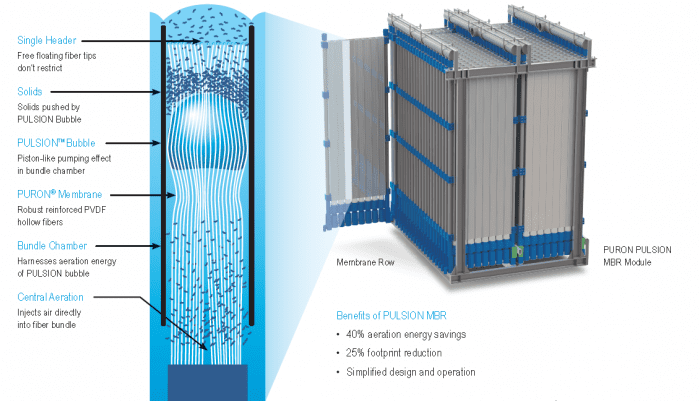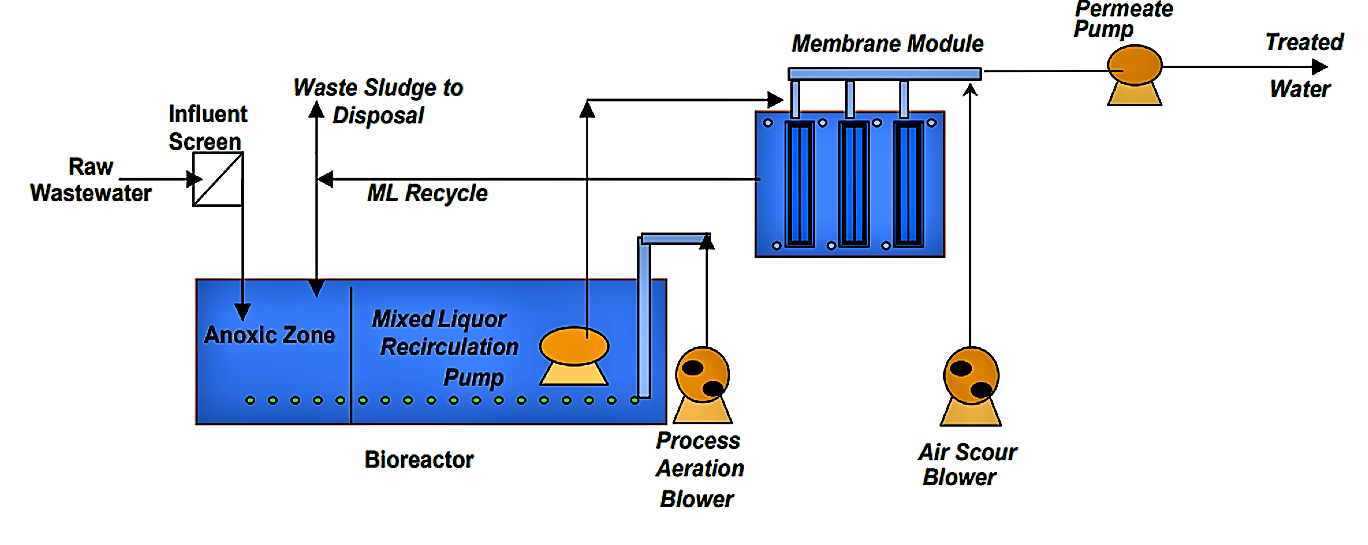Membrane Bioreactor Systems: A Key Technology for Water Reuse and Recycling
Membrane Bioreactor Systems: A Key Technology for Water Reuse and Recycling
Blog Article
How Membrane Layer Bioreactors Are Revolutionizing Water Purification Solutions
The introduction of membrane bioreactors (MBRs) stands for a substantial advancement in the area of water purification, merging biological therapy procedures with cutting-edge membrane layer filtering technologies. This combination not only boosts the quality of treated effluent however likewise addresses urban room restrictions, making MBRs particularly appropriate for densely populated areas. As international water shortage increases, the duty of MBRs in promoting drinkable water reuse and sustainable water administration comes to be significantly essential. The effects of this innovation extend beyond efficiency-- what obstacles and possibilities lie in advance for its widespread implementation?
Introduction of Membrane Layer Bioreactors
Membrane bioreactors (MBRs) represent a substantial development in water filtration technology, as they incorporate biological therapy procedures with membrane layer filtration. This integration enhances the efficiency of wastewater therapy by utilizing bacteria to deteriorate natural toxins while concurrently using semi-permeable membrane layers to separate treated water from put on hold virus and solids.
The MBR system typically includes a biological reactor where the microbial populace metabolizes contaminants, followed by a membrane purification system that maintains biomass and permits only clean water to pass through. This dual capability leads to greater effluent high quality compared to traditional treatment techniques. MBRs can be run in both batch and continuous flow modes, using versatility in style and application.
They additionally make it possible for the healing of water for reuse, thus adding to water sustainability initiatives. In general, MBRs are at the leading edge of enhancing water therapy performance and high quality, showcasing the possibility for innovative options in environmental administration.
Benefits of MBR Technology
The integration of biological treatment with membrane layer filtering offers numerous advantages for water filtration procedures. Among the main benefits of Membrane layer Bioreactor (MBR) technology is its capability to successfully get rid of both not natural and natural contaminants, causing high-quality effluent. The membranes act as a physical obstacle, avoiding suspended solids and virus from going through, which improves the overall safety and integrity of cured water.
In addition, MBR systems need a smaller impact contrasted to conventional therapy techniques, enabling a lot more efficient space utilization. This portable design is specifically useful in metropolitan settings where land is restricted. MBRs also show functional versatility, accommodating differing influent qualities and circulation prices without significant efficiency degradation.
Furthermore, the procedure offers enhanced nutrient elimination capabilities, specifically for nitrogen and phosphorus, which are essential for stopping eutrophication in receiving waters. The minimized sludge manufacturing related to MBR technology likewise converts to reduce disposal expenses, making it an economical service in the long run - Membrane Bioreactor. On the whole, the advantages of MBR modern technology placement it as a leading choice for cutting-edge and lasting water purification systems, resolving both environmental and financial problems
Applications in Water Filtration
Applications of Membrane Bioreactor (MBR) modern technology in water purification are impactful and varied, dealing with numerous treatment requires throughout multiple industries. MBRs efficiently incorporate biological therapy procedures with membrane layer filtering, making them suitable for community wastewater therapy, industrial effluent administration, and even potable water reuse efforts.
In metropolitan setups, MBRs are progressively used to improve the high quality of treated wastewater, permitting compliance with strict discharge policies and assisting in the recycling of water for watering and non-potable usages. Their compact design likewise makes them suitable for metropolitan environments where room is limited.
Industrially, MBR innovation is utilized to treat process water and wastewater, especially in industries such as food and drink, pharmaceuticals, and textiles. By effectively removing impurities and put on hold solids, MBRs assist markets decrease environmental effects while recovering valuable resources from wastewater streams.
Additionally, MBRs are acquiring grip in decentralized water therapy applications, where small systems can be released in remote areas or developing regions. This flexibility makes it possible for areas to accomplish sustainable water monitoring remedies, boosting access to clean water while reducing reliance on typical treatment techniques.
Study and Success Stories

In an additional example, a textile manufacturing center in Bangladesh took on MBR modern technology to resolve its wastewater difficulties. The system minimized chemical oxygen demand (COD) degrees from 1,200 mg/L to less than 100 mg/L, hence meeting regulatory standards and dramatically reducing environmental influence.
The College of Cape Community's MBR installment has shown reliable in treating greywater for non-potable reuse on university. This task not just saves drinkable water however also works as an instructional design for sustainable techniques.
Moreover, a seafood processing plant in Norway made use of MBR modern technology to deal with effluents consisting of high levels of raw material, attaining over 90% toxin elimination. These study underscore MBR innovation's versatility and its important duty in improving water top quality throughout diverse applications.
Future of Water Therapy Solutions
As global water shortage and pollution challenges escalate, cutting-edge water therapy solutions are ending up being progressively important to ensure sustainable access to clean water. The future of water treatment depends on the integration of innovative innovations that improve the effectiveness and efficiency of filtration procedures. Membrane layer bioreactors (MBRs) go to the center of click here to read this development, incorporating biological therapy with membrane purification to generate high-grade effluent suitable for different applications.

Emerging patterns such as source healing from wastewater, including nutrients and energy, will certainly further change treatment facilities right into environment-friendly hubs. Innovations in nanotechnology and membrane materials guarantee improved performance and long life of filtration systems.

Conclusion
In conclusion, membrane layer bioreactors stand for a significant advancement in water purification innovations, effectively integrating biological treatment with sophisticated membrane layer filtration. The various advantages, consisting useful reference of boosted effluent high quality and decreased spatial requirements, make MBRs particularly ideal for city applications. Their duty in drinkable water reuse and sustainable water administration highlights their importance in dealing with global water scarcity difficulties. Continued r & d will even more improve the efficiency and adoption of MBR innovation, making sure a resistant future for water treatment remedies.
The appearance of membrane layer bioreactors (MBRs) stands for a considerable advancement in the area of water purification, combining biological therapy procedures with innovative membrane layer filtering their explanation technologies. As international water scarcity escalates, the role of MBRs in assisting in potable water reuse and sustainable water administration comes to be increasingly important. They also allow the recuperation of water for reuse, thus contributing to water sustainability campaigns.As international water deficiency and air pollution challenges magnify, ingenious water therapy options are coming to be significantly crucial to ensure sustainable accessibility to tidy water. Their function in drinkable water reuse and sustainable water management highlights their importance in resolving international water shortage challenges.
Report this page